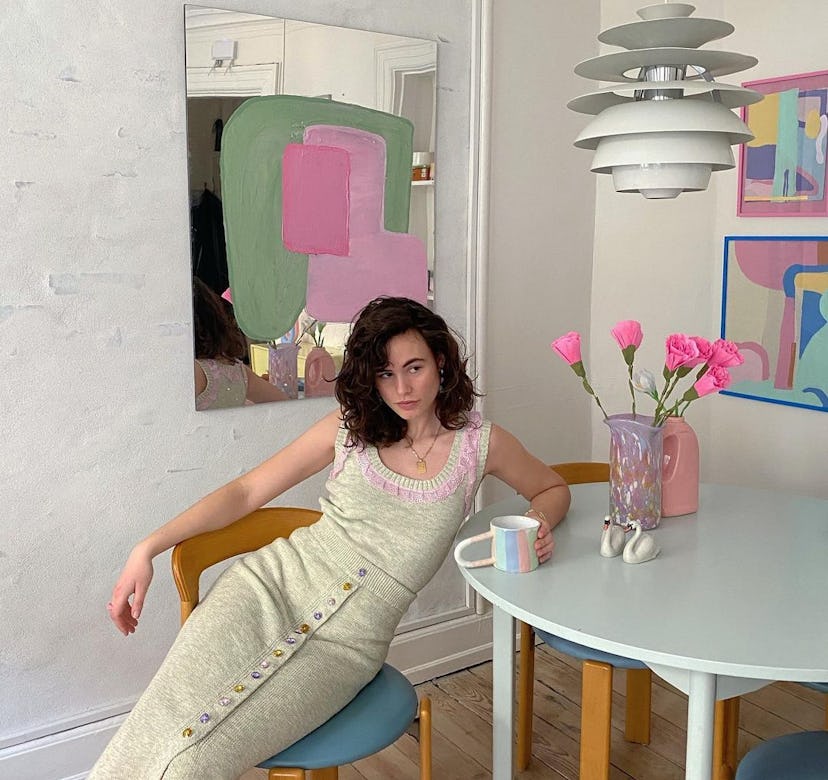(Home)
Yes, Pastel Decor Can Look Sophisticated — Here’s How
No nursery vibes here.

When Millennial Pink became a thing, it felt novel; people couldn’t get enough of the pastel shade because it seemed unexpected and practically made for improving Instagram photos. Nowadays, though, pastels of all kinds are everywhere — visit a cool new restaurant, open up your Instagram, or go shopping, and you’re guaranteed to see a rainbow of soft shades everywhere you look. And it’s tempting to jump on the trend. After all, the colors are pretty and often soothing (plus, right now, they seem to be considered about as stylish as it gets). Yet they present a conundrum: How do you decorate with pastels while still maintaining a grown-up aesthetic?
To start, it’s worth exploring why you might even try this saccharine color family in the first place. For many, it’s a way to break out of the all-white-everything mold and test a new scheme in the home. “We are seeing a lot more clients opt for pastel paint finishes in their bathrooms and even in their kitchens; it's an easy way to add a pop of color that can always be changed down the road,” Paul Morimoto, Head of Design at Block Renovation, tells TZR. “This time last year clients were opting primarily for neutral shades; more recently nearly a third of our clients are opting for some sort of color.ᐧ”
According to Alessandra Wood, VP of Style at Modsy, decorating with pastels can also be a way to infuse a fresh mood — something that’s been much needed as of late. “The new pastel trend seems to be v2 of Millennial Pink, introducing an array of light and airy colors with a youthful vibe,” she says in an email. “I think people are gravitating towards these colors as there is a softness to them. They are youthful and fresh feeling.”
If that resonates with you, consider starting your pastel journey with one of the current most popular shades — aka pink hues, says Michelle Bove, founder of DesignCase. “They have become a more broad take on the ‘Millennial Pink’ we saw five or so years ago,” she explains in an email. “I have used one of these offshoots of the color myself in my living room [with] a white zinfandel, which is a white with pink undertones that really warms up the room and gives it a boost of sophistication.”
For more ways to decorate with pink — and all other pastels — in a non-childish way, continue reading for Bove and Wood’s tried-and-true tips.
Use Contrast
“To avoid looking like a child’s bedroom or an Easter party, pair pastels with deeper, more saturated hues,” says Wood. Her favorite combinations? “I love to see blush paired with navy blue and mustard; this color combination creates drama in a sophisticated way.” And if you’re looking for something classic, she continues, try a lavender mix. “Pairing with navy blue, eggplant, and magenta really elevates this to a grown-up color palette.”
Bove agrees, and recommends dark gray or black accents with lighter hues “as the stark contrast make the pastels stand out.” But for her, contrast isn’t *just* about the color. “Pairing a pastel with warm wood tones or the use of a sophisticated tile can enhance the look,” she says.
Avoid Pastel On Pastel
If you’ve ever seen a room that features every pastel under the sun, you probably already know to avoid pairing several together. Wood reiterates this, explaining that it’s a good general rule to skip this; otherwise, you’re sure to get “Easter vibes.” It’s not just pastels on pastels to steer clear of, though — she also explains that using white as a base color can give this effect as well. If sophistication is the goal, contrast is probably your best bet.
Go Monochromatic
Though you may not achieve your goal by pairing different pastels together, Wood says you can create a sophisticated room by utilizing variants of the same shade. “I love to see pastels in a monochromatic design scheme where a room is filled with different shades of the same color,” she shares. “I also love the use of pastel as wall colors, especially when walls and trim are painted the same shade.”
Test The Shade
While trying a color in a space is always important, Bove says that’s especially true for pastels. (It’s all too easy for that soft, pretty pink to turn garish or sickly sweet in the wrong room, after all.) “Always look at a sample in the space you will install in before you do. When you look at the color in the paint store or furniture showroom they will likely be different lighting and it won’t look the same in the space you plan to use it in,” explains Bove. “Test it out before you commit to it!”
We only include products that have been independently selected by TZR's editorial team. However, we may receive a portion of sales if you purchase a product through a link in this article.
This article was originally published on